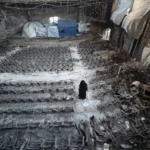As Ukraine looks ahead to post-war military restructuring, several critical trends are reshaping its defense strategy. While negotiations and potential ceasefire talks continue to unfold, Kyiv faces a difficult balancing act: preserving its sovereignty and deterring future attacks from Russia, all while managing the enormous cost of reconstruction and handling a displaced population. One thing is clear: Ukraine’s military in the future will be smaller in terms of manpower but significantly more reliant on advanced technologies, especially drones, to defend its borders.

Trend 1: The Rise of Drone Warfare
The ongoing war in Ukraine has shown that drones are now a cornerstone of modern combat. Drones have allowed Ukraine to hold off Russian advances, despite being outnumbered, by employing a combination of artillery, electronic warfare, and unmanned aerial vehicles. Small, inexpensive drones have emerged as key players on the battlefield, marking a shift in military strategy. These drones are being used to target Russian positions with pinpoint accuracy and deny large-scale territorial advances.
Ukraine’s resilience in this domain has led to the formation of new drone battalions and a decentralized approach to drone manufacturing, with civilian sectors now involved in mass production. Over the course of the war, Ukraine has increased its drone output from just a handful of companies in 2022 to over 500 by 2025. Thanks to deregulation and government support, Ukraine is on track to produce over 2.5 million drones annually. This is not just a temporary fix; it signals a long-term shift toward drone-dependent defense strategies, with a focus on maximizing technological and industrial capabilities.

Trend 2: Demographic Decline and Its Impact on Military Composition
As Europe faces demographic decline, Ukraine is no exception. The war has exacerbated the country’s population challenges, which were already in decline due to low birth rates and emigration. Before the war, Ukraine’s population stood at 52.5 million, but by 2024, it had fallen to just 37.9 million. With a significantly reduced population, the country faces difficulties in maintaining a large standing army. As a result, older generations, including volunteers over the age of 60, have taken up arms to defend their country.
This demographic shift means that Ukraine will have to rely more on drones and less on traditional manpower. The country’s conscription laws have adapted, limiting conscription to men between the ages of 25 and 60, further solidifying the importance of unmanned systems in future military planning. With fewer soldiers available for frontline service, drones are becoming the preferred means of defense, allowing Ukraine to defend its borders with minimal human loss.

Trend 3: The New Missile Age
As missile technology continues to evolve, it is transforming the way warfare is conducted. Russia, despite struggling to make significant advances on the ground, has leveraged support from Iran, China, and North Korea to produce mass quantities of long-range attack drones and missiles. This shift has resulted in a new form of warfare, one in which civilian infrastructure becomes a primary target. The use of missiles and drones to strike from a distance, as demonstrated in Russia’s recent attacks on Kyiv, highlights the growing reliance on aerial bombardments to inflict damage without risking soldiers on the ground.
Ukraine’s military must adapt to this new reality by enhancing its air defense capabilities. The Ukrainian military’s existing defenses have been bolstered by Western support, but the country will need to invest in next-generation technologies like high-powered microwaves, lasers, and advanced missile interceptors. This will be essential to countering Russia’s growing missile arsenal and ensuring Ukraine’s ability to defend itself from long-range attacks.

The Future Ukrainian Military: A New Vision
Looking ahead, the post-war Ukrainian military will be markedly different from its 2022 predecessor. While it will still need a human presence for strategic operations, the force will be smaller, with drones playing an even more central role. Several key strategies will shape this transformation:
- Drone Warfare Expansion: Ukraine must continue to prioritize drone technology. Maintaining and expanding the drone industry—supported by both the state and private sectors—will be crucial to ensuring that Ukraine remains capable of defending itself without relying heavily on human soldiers. In this new era of warfare, Ukraine’s military will need to integrate both unmanned aerial and ground systems into a cohesive fighting force.
- Layered Air Defense: To protect against long-range missile strikes, Ukraine will need to expand its air defense network. This will include not only upgrading existing systems but also investing in advanced technologies such as high-energy lasers and automated counter-drone systems. These innovations will be necessary to intercept Russia’s growing missile and drone threats.
- Strategic Reserve and National Service: As the need for a large standing army diminishes, Ukraine will need to rethink its reserve force model. Instead of traditional military reserves, the country should create a national service program that integrates civilians into defense efforts. This could involve training computer scientists, engineers, and drone operators, who would be called upon during times of national crisis. By blending civilian skills with military needs, Ukraine can build a more flexible and resilient defense infrastructure.

Conclusion: A New Military Paradigm
The future of the Ukrainian military will be defined by technology, not manpower. With drones, missiles, and advanced air defense systems taking center stage, the country will be able to maintain a defensive posture while also ensuring that its military remains agile and adaptable. As Ukraine continues to rebuild and recover from the war, it will need to invest heavily in technology, education, and innovation to ensure its sovereignty and deter future aggression.
While the challenges are immense, the shift toward a more tech-centric military offers Ukraine a path forward—one that balances national defense with the pressing need for economic recovery. By embracing drones, harnessing the power of technology, and reimagining its military structure, Ukraine can secure its future and defend its sovereignty in an increasingly unpredictable world.
Author Profile
- Syed Tahir Abbas is a Master's student at Southwest University, Chongqing, specializing in international relations and sustainable development. His research focuses on U.S.-China diplomacy, global geopolitics, and the role of education in shaping international policies. Syed has contributed to academic discussions on political dynamics, economic growth, and sustainable energy, aiming to offer fresh insights into global affairs.
Latest entries
 GeopoliticsAugust 23, 2025Previewing the White House Visit of South Korean President Lee Jae Myung
GeopoliticsAugust 23, 2025Previewing the White House Visit of South Korean President Lee Jae Myung Middle East ConflictJuly 22, 2025Israel’s Deadly Attacks on Gaza: A Dire Humanitarian Crisis and International Calls for a Truce
Middle East ConflictJuly 22, 2025Israel’s Deadly Attacks on Gaza: A Dire Humanitarian Crisis and International Calls for a Truce Middle East & North AfricaJuly 20, 2025Israel Targets Damascus Amid Rising Tensions in Syria
Middle East & North AfricaJuly 20, 2025Israel Targets Damascus Amid Rising Tensions in Syria Middle East AffairsJuly 14, 2025An Open Letter from Gaza’s University Presidents: Resisting Scholasticide Through Education
Middle East AffairsJuly 14, 2025An Open Letter from Gaza’s University Presidents: Resisting Scholasticide Through Education



1 comment
Your story truly touched me. I relate to it deeply, and your honesty gave me a fresh perspective. Thank you for sharing!